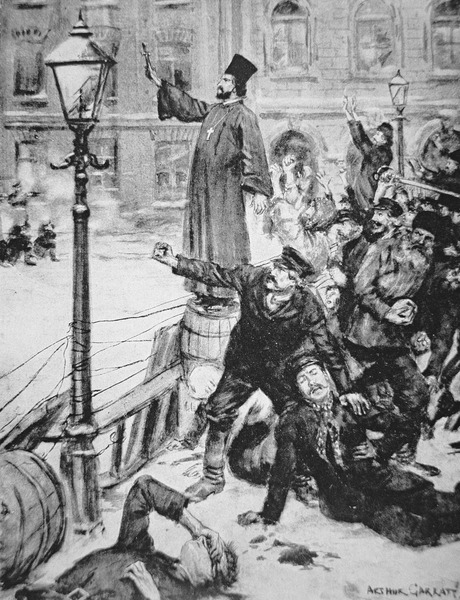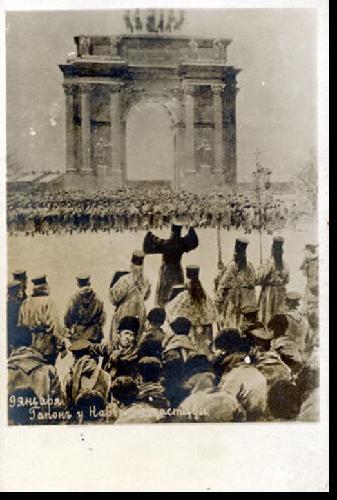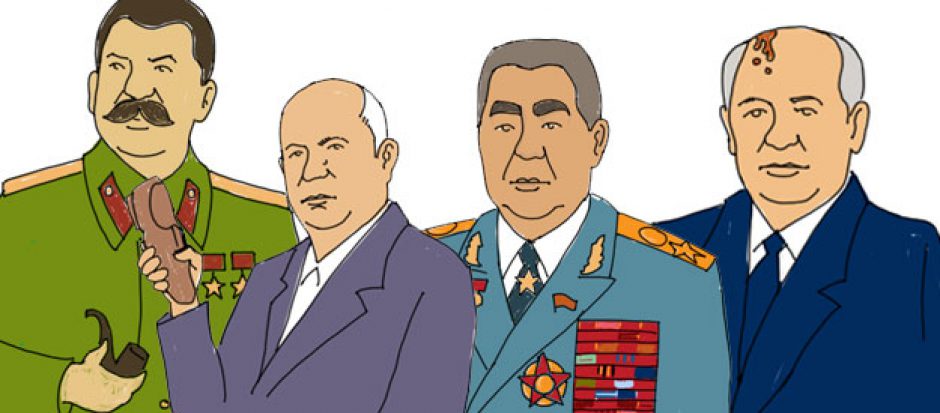
PNP368919 Father Gapon leads the public protest to the Winter Palace, St. Petersburg on 22nd January 1905 (litho) by Garratt, Arthur Paine (1873-c.1920); Private Collection; (add.info.: Georgy Apollonovich Gapon (1870-1906) was a Russian Orthodox priest and popular working class leader before the Russian Revolution of 1905; at this demonstration troops fired into the crowd;); Peter Newark Pictures; English, out of copyright
By the turn of the 20th century, Tsar Nicholas II was beginning to see the limits of his autocratic rule. Not only was his military in the midst of an embarrassing defeat to the Japanese, but at home his own people were becoming increasingly displeased with Russia’s outdated government. There was a wide range of political “parties,” such as the Constitutional Democrats (Kadets) , the Russian Social Democratic Workers’ Party , and the Party of Socialist Revolutionaries (SR). Each of these parties had different ideas for how to achieve change and what kind of change they wanted to see. They debated over complex decisions, such as whether the revolution should be violent or peaceful and whether or not to establish a socialist government immediately or to implement a capitalist system.
But while these details were being hashed out, the ones who would bring revolution to Russia – the workers and peasants – were becoming more and more unhappy with their poor working conditions and lack of a political voice. When workers at a factory in Putilov were abruptly dismissed, it was these average Russians who would would gather and march on the Winter Palace. And it was these average Russians who would be shot by the palace guards in the event later known as Bloody Sunday, kicking off the Revolution of 1905.

- Father Gapon leads petitioners at the Narva Gate
Leading these average Russians was Father Georgii Gapon, a zealous Orthodox priest who headed the Assembly of Russian Factory Workers. Father Gapon is a key figure in the 1905 Revolution not because his political savviness or experience; He was significant because of his ability to connect the average Russian with the revolutionary movement. He was the same stratum as the workers and peasants, and even Lenin regarded him as an unconscious instrument of the revolution, like most of the Russian people.
Father Gapon was Every Russian. He marched on the Winter Palace not to overthrow the Tsar or to implement socialism or capitalism, but to secure more rights and freedom for the Russian people. He led the petitioners on Bloody Sunday because he, like the Russian people, had no other legitimate means to effect change. His own words written in his petition best sum up the intentions of Father Gapon and every Russian, saying:
“We workers, our children, our wives and our old, helpless parents have come, Lord, to seek truth and protection from you. We are impoverished and oppressed, unbearable work is imposed on us, we are despised and not recognized as human beings. We are treated as slaves, who must bear their fate and be silent. We have suffered terrible things, but we are pressed ever deeper into the abyss of poverty, ignorance and lack of rights.”



I like how you chose a religious figure as the focus of your blog post. I don’t remember reading about Father Gapon in the reading this week, but it was nice to read about how someone with a larger importance to many of these working people also has a motivational role in the revolutionary movement. Like you said, he shows how every Russian was working towards these changes in the government that allow for the people to play a larger role in legislation.
LikeLike
I agree with Elizabeth. Great job on focusing on one of the leaders of the Bloody Sunday protest and examining his impact and leadership of the peasants/workers and other common Russians. I also like how you pointed out Lenin’s praise of Gapon – I’ve never seen this before. Keep up the good work!
LikeLike
I thought this was a really interesting post and agree with the other comments– it was cool to see how Gapon fulfilled a lot of Lenin’s ideals. I also liked how you focused on the average nature of the revolution, and it was these average Russians that created the most change in Russia during this time.
LikeLike
Very interesting post. Great job emphasizing how Gapon was nothing more than a common Russian and not some large blow up figure head. The idea that he spoke for the common Russian and led the march to the Winter Palace certainly solidifies his role in the revolution. Great job organizing your thoughts!
LikeLike
Tell me more about Lenin on Gapon. Why would Lenin characterize him as an “unconscious instrument”? What is that, anyway?
LikeLike
The context for the quote is that Lenin looked upon Father Gapon as an important figure, but not one that deliberately advanced the Revolution. I think he said it because Gapon’s organization was sanctioned and assisted by the police, and Lenin believed that the government permitted them to protest in order to make a spectacle out of shutting the protest down in order to discourage the revolution. So in that sense, Father Gapon unknowingly led the petitioners into a massacre, which unexpectedly ignited protests across Russia. I think by “unconscious instrument,” Lenin meant that Gapon was not seeking a revolution, but his actions played a key part in the Revolution of 1905.
LikeLiked by 1 person
I talked about Father Gapon and Bloody Sunday as well in my blog. Glad to see someone else took an interest in him. Lenin’s praise of him is understandable since the protest brought more support to the revolutionists. Great job examining Gapon’s charisma and leadership of Russian factory workers.
LikeLike
First of all I LOVE the title of the post. I think my own post was trying to get at that notion as well: Bloody Sunday wasn’t just a march-gone-bad, it was something that almost every Russian outside of the aristocracy/nobility could relate to. Fr. Gapon’s work assimilating the masses was a huge catalyst in the beginning the 1905 Revolution.
LikeLike
After reading your post, I was fascinated by the figure of Father Gapon and wish I had researched and done my post on him and the influence he had on the Russian revolutionary spirit. Very interesting historical figure and certainly one who is inspiring in a very real and apolitical way. He wasn’t seeking political power, simply saw injustice and did what he could for Russia and the Russian people.
LikeLike
After submitting this comment I was reminded of the images I saw from Ukraine during the unrest they experienced in our lifetimes. Here, as in 1905, the Orthodox clergy are at the forefront of the upheaval and seem to play a very crucial role in inspiring people to action.

LikeLiked by 1 person